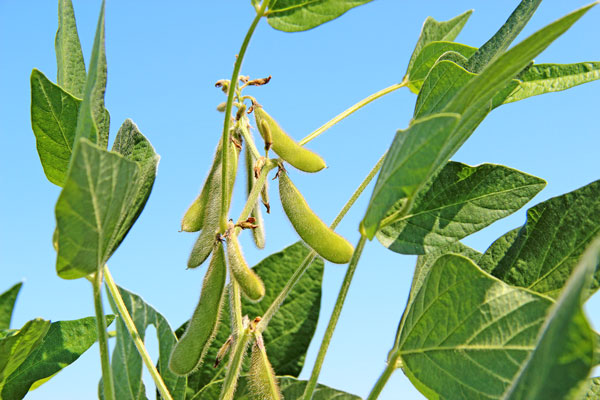
Resistant earworms, budworms likely in North Carolina soybeans
• Since the spray was a full rate of a pyrethroid, it is likely these insects are resistant to this chemical. • We simply cannot predict the areas in which pyrethroids will fail. • Weknow we have resistant worms in our system. The safe bet is to spray a chemical other than a pyrethroid.
August 15, 2013

I received several calls earlier this week concerning the corn earworm in our North Carolina soybean crop.
These reports were unusual for at least one reason. Earworms seem widespread geographically, but are spotty from field to field.
Generally moths prefer to lay eggs in flowering soybeans, but two consultants have found earworms defoliating fields with young beans at V2-V3 (in addition to the usual).
Our threshold for defoliation prior to reproductive stages is 30 percent throughout the canopy. However, our crop is very late this year and we need all the foliage we can get to set a decent yield. It might be a good idea to temporarily lower the threshold to 15 percent to avoid losing too much on these young plants.
If the worms are already large, they will likely cycle out soon, so you might want to hold out on these situations.
I have also received several calls on spray failures in both soybeans and peanuts. I identified worms from Pamlico County, comparing sprayed to unsprayed fields in this case. The 14 worms I identified from the unsprayed field were all corn earworm.
However, in the sprayed field, 25 percent of the worms were tobacco budworm. This insect is tolerant to pyrethroids so the spray likely selected for these.
Looks like resistance
The disturbing fact was that 75 percent of the remaining worms were corn earworm. Since the spray was a full rate of a pyrethroid, it is likely these insects are resistant to this chemical.
Jack Bacheler has a somewhat different perspective, identifying worms from soybeans and peanuts that ranged from 90 percent to 100 percent tobacco budworm in the Rocky Mount area. Based on these findings, we are concerned about pyrethroid spray failures.
Last year, I tested moths for pyrethroid tolerance, measuring over 50 percent surivorship in one area and 0 percent survivorship from a trap 5 miles away. This, combined with our experience with spray failures, tells us we simply cannot predict the areas in which pyrethroids will fail.
You could spray one field and have great control, drive down the road and have a complete failure, due to presence of tobacco budworm, resistant corn earworm, or both.
Because moths flights have been so low this year, I have only been able to test moths once (this past Monday) for pyrethroid tolerance — despite sampling 3 times a week since June.
From a five trap loop in Washington County, I found, on average, 13 percent moths that survived a night in a pyrethroid-treated vial. In contrast, Ames Herbert, in Suffolk, Va., is finding surivorship around the 30 percent range.
In summary, we know we have resistant worms in our system. The safe bet is to spray a chemical other than a pyrethroid. The diamides, like Belt and Prevathon are some examples.
Syngenta has a new registration for Besiege, which is a pre-mixed product containing the active ingredient of Prevathon, plus a pyrethroid (lambda-cyhalothrin, aka Karate).
Blackhawk (Tracer) offers a unique chemistry class, the spinosyns, and is highly effective against corn earworm.
Steward promising
Finally, in every trial I’ve had it and at every rate (as low as 6.7 oz/A), Steward, which is also a unique type of chemistry, has been the most effective or among the most effective chemical for corn earworm, even at lower rates.
Each product has advantages or disadvantages. For example, the residual of the diamides is very good, but may not be a concern since only one generation of corn earworm a year generally develops in soybeans.
Want access to the very latest in agriculture news each day? Subscribe to Southeast Farm Press Daily. It’s free!
However, in some years (like 2010) we can have multiple infestations, as well as late-season pests, like soybean loopers and fall armyworms. These products are excellent choices in these situations.
Above all, rotate chemistry and only spray at threshold.
The threshold for corn earworm is online and can be accessed using arecently updated threshold calculator (click here). This threshold is specifically for podding soybeans (R4-R7). It also is accessible from mobile devices and can be used in the field.
This threshold is already conservative and there should be no need to adjust it. This is set below the break-even point where the cost of control is equal to the damage the worms are doing.
More from Southeast Farm Press
North Carolina kudzu bug migration nearing peak
Heavy rains cause Florida Panhandle farmers, ranchers problems
Peanuts, corn, soybeans highlight upcoming South Carolina field day
USDA to survey Southeast small grains growers in early September
You May Also Like



